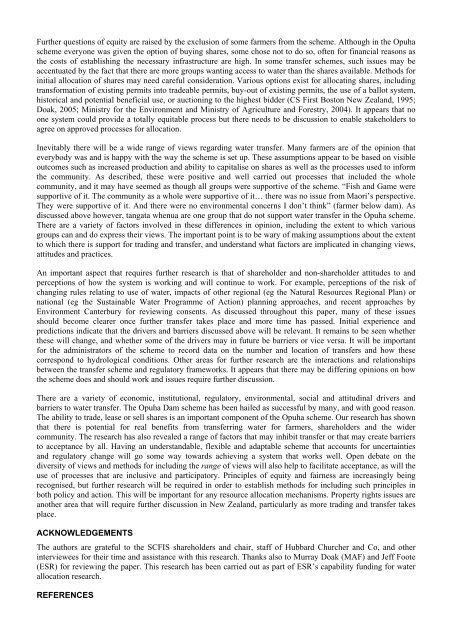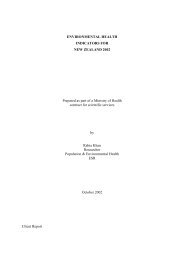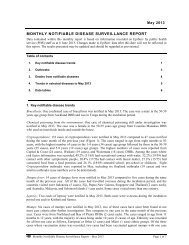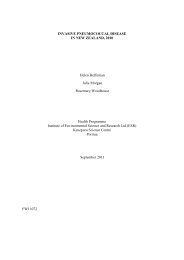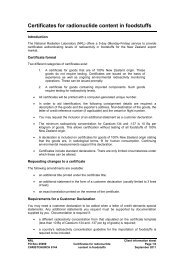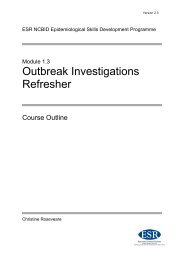Water Transfer in Context â A New Zealand Case Study
Water Transfer in Context â A New Zealand Case Study
Water Transfer in Context â A New Zealand Case Study
You also want an ePaper? Increase the reach of your titles
YUMPU automatically turns print PDFs into web optimized ePapers that Google loves.
Further questions of equity are raised by the exclusion of some farmers from the scheme. Although <strong>in</strong> the Opuhascheme everyone was given the option of buy<strong>in</strong>g shares, some chose not to do so, often for f<strong>in</strong>ancial reasons asthe costs of establish<strong>in</strong>g the necessary <strong>in</strong>frastructure are high. In some transfer schemes, such issues may beaccentuated by the fact that there are more groups want<strong>in</strong>g access to water than the shares available. Methods for<strong>in</strong>itial allocation of shares may need careful consideration. Various options exist for allocat<strong>in</strong>g shares, <strong>in</strong>clud<strong>in</strong>gtransformation of exist<strong>in</strong>g permits <strong>in</strong>to tradeable permits, buy-out of exist<strong>in</strong>g permits, the use of a ballot system,historical and potential beneficial use, or auction<strong>in</strong>g to the highest bidder (CS First Boston <strong>New</strong> <strong>Zealand</strong>, 1995;Doak, 2005; M<strong>in</strong>istry for the Environment and M<strong>in</strong>istry of Agriculture and Forestry, 2004). It appears that noone system could provide a totally equitable process but there needs to be discussion to enable stakeholders toagree on approved processes for allocation.Inevitably there will be a wide range of views regard<strong>in</strong>g water transfer. Many farmers are of the op<strong>in</strong>ion thateverybody was and is happy with the way the scheme is set up. These assumptions appear to be based on visibleoutcomes such as <strong>in</strong>creased production and ability to capitalise on shares as well as the processes used to <strong>in</strong>formthe community. As described, these were positive and well carried out processes that <strong>in</strong>cluded the wholecommunity, and it may have seemed as though all groups were supportive of the scheme. “Fish and Game weresupportive of it. The community as a whole were supportive of it… there was no issue from Maori’s perspective.They were supportive of it. And there were no environmental concerns I don’t th<strong>in</strong>k” (farmer below dam). Asdiscussed above however, tangata whenua are one group that do not support water transfer <strong>in</strong> the Opuha scheme.There are a variety of factors <strong>in</strong>volved <strong>in</strong> these differences <strong>in</strong> op<strong>in</strong>ion, <strong>in</strong>clud<strong>in</strong>g the extent to which variousgroups can and do express their views. The important po<strong>in</strong>t is to be wary of mak<strong>in</strong>g assumptions about the extentto which there is support for trad<strong>in</strong>g and transfer, and understand what factors are implicated <strong>in</strong> chang<strong>in</strong>g views,attitudes and practices.An important aspect that requires further research is that of shareholder and non-shareholder attitudes to andperceptions of how the system is work<strong>in</strong>g and will cont<strong>in</strong>ue to work. For example, perceptions of the risk ofchang<strong>in</strong>g rules relat<strong>in</strong>g to use of water, impacts of other regional (eg the Natural Resources Regional Plan) ornational (eg the Susta<strong>in</strong>able <strong>Water</strong> Programme of Action) plann<strong>in</strong>g approaches, and recent approaches byEnvironment Canterbury for review<strong>in</strong>g consents. As discussed throughout this paper, many of these issuesshould become clearer once further transfer takes place and more time has passed. Initial experience andpredictions <strong>in</strong>dicate that the drivers and barriers discussed above will be relevant. It rema<strong>in</strong>s to be seen whetherthese will change, and whether some of the drivers may <strong>in</strong> future be barriers or vice versa. It will be importantfor the adm<strong>in</strong>istrators of the scheme to record data on the number and location of transfers and how thesecorrespond to hydrological conditions. Other areas for further research are the <strong>in</strong>teractions and relationshipsbetween the transfer scheme and regulatory frameworks. It appears that there may be differ<strong>in</strong>g op<strong>in</strong>ions on howthe scheme does and should work and issues require further discussion.There are a variety of economic, <strong>in</strong>stitutional, regulatory, environmental, social and attitud<strong>in</strong>al drivers andbarriers to water transfer. The Opuha Dam scheme has been hailed as successful by many, and with good reason.The ability to trade, lease or sell shares is an important component of the Opuha scheme. Our research has shownthat there is potential for real benefits from transferr<strong>in</strong>g water for farmers, shareholders and the widercommunity. The research has also revealed a range of factors that may <strong>in</strong>hibit transfer or that may create barriersto acceptance by all. Hav<strong>in</strong>g an understandable, flexible and adaptable scheme that accounts for uncerta<strong>in</strong>tiesand regulatory change will go some way towards achiev<strong>in</strong>g a system that works well. Open debate on thediversity of views and methods for <strong>in</strong>clud<strong>in</strong>g the range of views will also help to facilitate acceptance, as will theuse of processes that are <strong>in</strong>clusive and participatory. Pr<strong>in</strong>ciples of equity and fairness are <strong>in</strong>creas<strong>in</strong>gly be<strong>in</strong>grecognised, but further research will be required <strong>in</strong> order to establish methods for <strong>in</strong>clud<strong>in</strong>g such pr<strong>in</strong>ciples <strong>in</strong>both policy and action. This will be important for any resource allocation mechanisms. Property rights issues areanother area that will require further discussion <strong>in</strong> <strong>New</strong> <strong>Zealand</strong>, particularly as more trad<strong>in</strong>g and transfer takesplace.ACKNOWLEDGEMENTSThe authors are grateful to the SCFIS shareholders and chair, staff of Hubbard Churcher and Co, and other<strong>in</strong>terviewees for their time and assistance with this research. Thanks also to Murray Doak (MAF) and Jeff Foote(ESR) for review<strong>in</strong>g the paper. This research has been carried out as part of ESR’s capability fund<strong>in</strong>g for waterallocation research.REFERENCES


